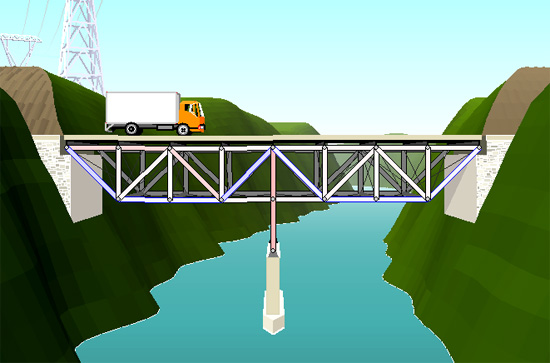Bridge
- Parametric Model
Deck Truss Bridge
A deck truss bridge is a type of bridge in which load bearing structure consists of trusses and deck slab is placed at the top of these trusses. These bridges are normally used to support heavy loads like railways and highways and preferred to build where mid to long spans are required. Different materials like wood or steel can be used but preferable material is steel now a days. These bridges are durable, cost effective and provide high strength to weight ratio. In our case, we have selected a Deck Truss Bridge for parametric modeling. The primary reason for selecting this bridge is its preference for low maintenance costs, long-lasting durability, and structural efficiency.
Design challenge
Our design challenge is to parametrically model the deck slab and the load bearing components of the bridge, such that any changes made in any of the parameters of the deck slab or these truss components can lead to an automatic adjustment of all the depending parameters of the structure. By changing the different parameter such as length or width of the bridge, deck thickness or number of vertical members, designer can easily modify the bridge. This will be achieved by ensuring the bridge’s design remains within extreme limits, preventing the geometrical model from being distorted due to inputs that fall outside the acceptable range for the design.
Parametric Modeling of Bridge
Parametric modeling is the process of creating 3D design based on defined parameters, enabling seamless modifications to the system design by adjusting these parameters. This process saves a lot of designer’s time and he can easily make any changes without redesigning the system. For our modeling we set some of the parameters to control our design which are given below:
Bridge span
Bridge width
Number of vertical members
Height of bottom chord
Design Alternatives
For different design configurations, we can change the design by changing the parameters. These alternatives aim to change the span of the bridge by changing parameters while maintaining structural stability. By changing the parameters we can easily modify our design according to the requirements.
High-Performance criteria
For achieving bridge’s high performance we can increase the thickness of deck slab, number of vertical members and their diameter. Firstly, a thicker deck slab provides greater strength and stiffness, reducing deflection and vibrations under various loads and enhanced durability. By using the node “Surface.Thicken” we can increase the thickness of deck slab. Secondly, when we increased the number ofvertical members it distributes loads from the deck to the truss more evenly, reducing stress on individual members and increase structural redundancy. Lastly, when we increased the diameter of vertical members it enhances the load-carrying capacity of the vertical members, improving the bridge’s ability to handle heavy and dynamic loads and reduce deflection in the deck under live loads, such as vehicles or trains.This enhances the stability of structure and provides good experience to its users. We can increase the diameter of vertical members by using the node “Solid.BySweep”. So, these parameters will control the performance of this bridge parametric model.
Conclusions
Parametric modeling offers significant flexibility to designers while reducing both cost and time. By modifying parameters, designs can be adjusted seamlessly, minimizing the manual errors often encountered during design iterations. The use of 3D parametric models enables designers to generate multiple design variations efficiently, leveraging real-time data to provide instant feedback on the impact of parameter changes. For large-scale projects, parametric modeling is indispensable, as adjustments to a single parameter automatically update the entire design, ensuring consistency and efficiency throughout the process.
References
- Smith, K., & Tardif, M. (2012). Building Information Modeling: A Strategic Implementation Guide for Architects, Engineers, Constructors, and Real Estate Asset Managers. Wiley.
- Eastman, C., Teicholz, P., Sacks, R., & Liston, K. (2011). BIM Handbook: A Guide to Building Information Modeling for Owners, Managers, Designers, Engineers, and Contractors. Wiley.
- Kensek, K. M., & Noble, D. (2014). Building Information Modeling: BIM in Current and Future Practice. Wiley.
- Woodbury, R. (2010). Elements of Parametric Design. Routledge.

